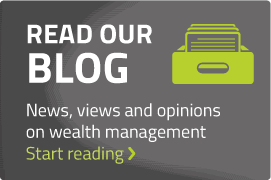June Market Commentary
In the three months to 31st May 2014 all asset classes produced positive returns. The world equity index returned +3.8% in US$ and +3.5% in £ sterling while the FTSE All Share returned +1.0% in sterling.
The emerging market index returned +7.1% in US$ and +6.8% in £ sterling. UK gilts and UK corporate bonds generated positive returns of +1.7% and +2.3% while index linked gilts made a positive return of +3.7%. Agricultural commodities rose by +1.6%, crude oil rose by +0.1% while metals, measured by the LMEX index, rose by +1.7% all in US$. UK commercial property showed a rise of +1.1%.
The main positive influence on market movements over the period was the evidence of continuing, if moderate, world economic output growth. The main negative influence was the persistence of increased geopolitical risk, a factor which continued after the end of the period with the outbreak of conflict in Iraq.
Equity volatility was notably low during the period. This is partly explained by the fact that the influence of better economic statistics and the persistence of central bank support, notably from the US Federal Reserve and the Bank of Japan, pull in opposite directions. The impact of positive economic news and has been reduced by fears that it may lead to a reduction in central bank support while the impact of negative news has been muted for the opposite reason, and this dynamic continues.
After the end of the period, on 5th June 2014 the European Central bank (ECB) announced a package of up to 400bn Euros of cheap loans for Eurozone banks, known as targeted longer-term refinancing operations (TLTROs), to increase lending to the region’s small businesses and cut its main refinancing rate to 0.15% from 0.25% and its deposit rate from 0.0% to minus 0.1%, making it the first major central bank to use negative interest rates. The accompanying statement also indicated that the ECB would go further and use outright purchases of asset-backed securities if this proved to be necessary.
The latest World Economic Outlook from the IMF (January 21st 2014) forecasts an improvement in world output growth from 3.0% in 2013 to 3.7% in 2014 and a further increase to 3.9% in 2015. The OECD’s Economic Outlook published on May 6th 2014, forecasts 3.4% and 3.9% world growth in 2014 and 2015.
US earnings in the first quarter of 2014, with more than 95% of the S&P 500 Index reported, show earnings growth of +4.9% against an expectation of an earnings decline.
Developed equity markets had a good 2013 and price appreciation was, on average, caused more by improvements in valuations, higher price earnings ratios for example, than by increases in earnings or cash-flows. Ratings had therefore become more demanding and prospective 2014 price to earnings ratios are somewhat above their 5 year averages as are other value measures, such as price to book value and price to sales ratios. Emerging market equities which fell over 2013 have valuation ratios below their five year averages. Average forecasts of company earnings show double figure, or high single figure increases for both developed and emerging market companies. This suggests that world equity markets still offer value even after last year’s rise if the forecast increases in earnings materialise. We continue to expect therefore that the next 12 months should see further price strength in equities, although in the shorter term some increase in volatility, as appeared in the early months of 2014, seems probable. We will continue to overweight this asset class.
UK property prices were positive over the quarter. Property yields still look very attractive compared with gilt yields and further price strength depends on a rise in rental levels. A trend of rising rents now seems to be underway with the first quarter of 2014 seeing a further increase. We believe that this should continue and we will continue to overweight the asset class.
Conventional gilts with a 10 year maturity continue to yield less than UK equities and look very expensive relative to equities on an historic yield basis. Furthermore the yield offered by 10 year gilts is still below its 10 year average and is likely to rise further when interest rates normalise. We think that gilt prices are still very expensive and will continue to underweight this asset class.
Alternative assets, including absolute return instruments can be a low volatility option to be used in lower risk portfolios, and in this context, given our view that conventional low risk assets are expensive, we will keep an overweighting of this class.
Index linked gilts now look fairly valued to slightly expensive relative to conventional gilts on a yield comparison. They have support however from their inflation uplift and we continue to consider this to be one of the less volatile investments, and are even weighting this class.
UK corporate bonds offer an excess yield offered over gilts which is now below its 5 year average, but there may be some scope for the spread to narrow further as balance sheets continue to improve. This asset class continues to be fairly valued and we are keeping it even weighted. In summary, equities are still on undemanding ratings given the improving growth outlook and we continue to favour them. We still consider conventional gilts to be dear. We will use alternative assets where appropriate in a low risk context. We consider index linked gilts to be fairly valued as are UK corporate bonds. We confirm our view that property is undervalued.
This information was taken from an article supplied by Albert E Sharp. For more information visit their website www.albertesharp.com
“Any reference to shares is not a recommendation to buy or sell. Should you wish to make a decision based on these notes we cannot take responsibility for this and you should carry out your own research before making a decision. You should note that past performance is not a reliable indicator of future returns and the value of your investments can fall as well rise.”




